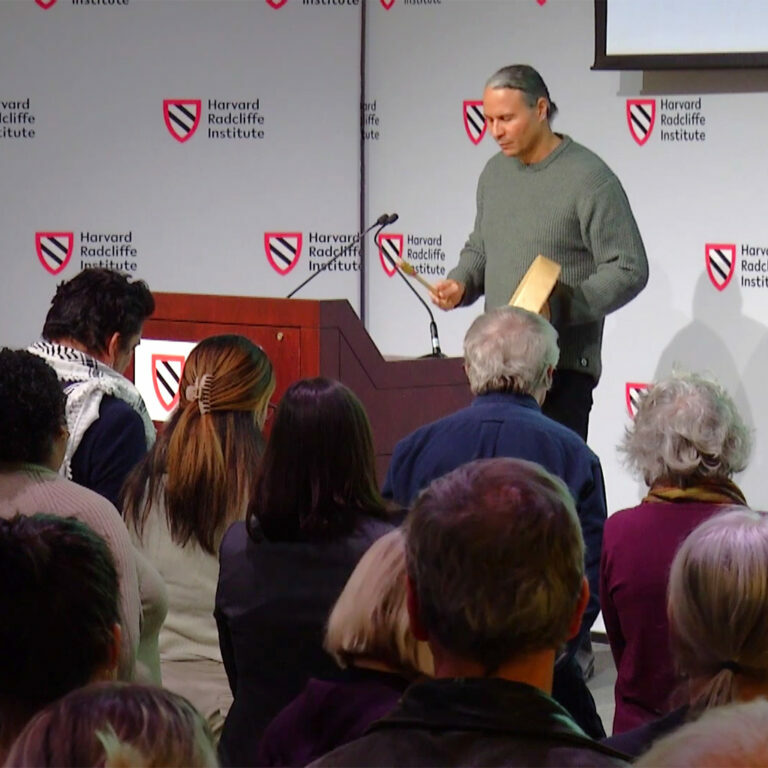
Celebration and advocacy for Native American history goes well beyond November
Above image: Larry Spotted Crow Mann of the Hassanamisco Nipmuc Band performs a hand drum honor song to open the Harvard Radcliffe Institute’s Responsibility and Repair Symposium on November 2nd 2023. (Photo: Harvard Radcliffe Institute)
By Beth Folsom
More than a century ago, activists began to campaign for a designated day of recognition for the contributions Indigenous peoples have made to the establishment and growth of the United States. In 1915, the Congress of the American Indian Association formally approved a plan concerning American Indian Day. Its leader, the Rev. Sherman Coolidge, issued a proclamation that Sept. 28 declaring the second Saturday of each May as an American Indian Day and contained the first formal appeal for recognition as citizens. In 1990, President George H.W. Bush issued an official declaration naming November as National Native American Heritage Month, an expansion that has continued for the past three decades.
The move by the national government to change the time of year reflects the strong correlation in the minds of many between Indigenous peoples and the Thanksgiving story. Traditionally portrayed as a tale of two cultures coming together in goodwill and harmony, the story of the harvest feast of 1621 in Plymouth is both much more complex and much less significant than it appears. For three days, English Pilgrims and members of the Wampanoag tribe shared food and fellowship, but the meaning of these celebrations differed – for the colonists, this was a time to give thanks for their survival in the “wilderness” of what they referred to as the New World; for the Wampanoag, it was a critical moment in which it became clear that the English were not visitors, but were to be a permanent fixture on their land and in their world.
Although Thanksgiving and its accompanying celebrations provide an opportunity to learn about Indigenous history, we need not be limited to November. Over the past year, a number of organizations in and around Cambridge have made strides to amplify Indigenous voices and add to our collective understanding of the role that Indigenous peoples have played in the city’s history, as well as its present. This past May, History Cambridge held a History Cafe program with Indigenous scholars Sage Carbone and David Shane Lowry to explore the Native history of the city and its environs, and to discuss ways in which we as a community can more fully engage with and learn about the stories of Indigenous Cambridge.
Recent Cambridge Day articles by History Cambridge staff and guest authors have asked what Cantabrigians know – and what they’re curious about – Indigenous history; explained the city’s participatory budgeting project to include Indigenous language on street signs; explored the landscape of the Alewife region before colonization; and uncovered the role of local universities in the erasure of Indigenous peoples and their history.
Other local papers have reflected a growing interest in and commitment to learning about Indigenous stories, and to holding local institutions accountable for their historical relationships with Native communities. As part of its reckoning with its own legacy of colonialism, Harvard University held a recent symposium on “Responsibility and Repair: Legacies of Indigenous Enslavement, Indenture and Colonization at Harvard and Beyond.” And the student newspaper, The Crimson, has featured a series of articles and editorials on the university’s historical relationship with Indigenous communities and its current responsibilities for restorative justice.
As part of its mission to collect and share the stories of all Cantabrigians, History Cambridge has created an Indigenous People’s History Hub with resources for learning about Indigenous experiences in and around the city, as well as connecting with other local organizations doing this important work. In 2018, History Cambridge created a land acknowledgment in commitment to doing good history and telling the whole story of Cambridge. Though acknowledging our occupation of Indigenous land is an important step in recognizing the presence of Indigenous life, we must also make a continued effort to learn from and engage with the past and present histories of Native life and culture in the spaces we occupy. The creation of this hub is only the beginning of these efforts. Over time we hope to expand the hub to fill gaps in recorded history and uplift the stories and voices of Indigenous peoples past and present.
How can you use the resources in the Indigenous People’s History Hub to look beyond November and the story of the first Thanksgiving? Read a book or journal article listed there, check out the links to the stories of Indigenous historical figures and explore links to the websites of Indigenous tribes and other organizations. Take action on one of the many pieces of legislation affecting Indigenous communities and see what events local communities are holding to learn about and celebrate their Indigenous history. And remember that Indigenous stories are still being created as well as commemorated in the past – the story of Indigenous Cambridge is still being written.
